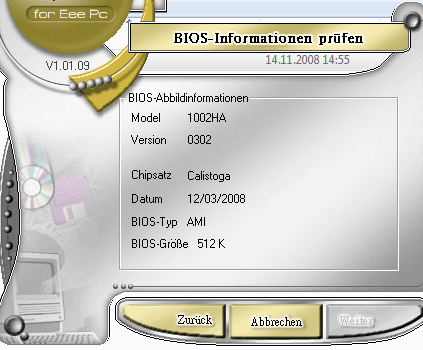STEP 1: LATEST BIOS VERSION
But it's a long way to reach the goal: First, it's recommended to update the BIOS to the latest version. If you don't do that Windows 7 will start with a black screen and you can only avoid it by pushing the power button for a few seconds to switch to the sleep mode and pressing the power button again to awake (normal screen will appear). But it's surely annoying to do that after every start.
So, in my case the BIOS had the version 0302 and the last one available is 1004. You can check the version with the Asus Update for EEE PC Update Tool and also update your BIOS (only if you're still using XP). Either try connecting with the internet or try to find the following ROM file by yourself: 1002HA-ASUS-1004.ROM
If you don't have the tool, then you can format an USB device with FAT16 (not FAT32, won't work!!!) and copy the ROM file to it. Rename the file to 1002HA.ROM.
Note: Devices bigger than 4GB can't be used with FAT16!
After that you just simply have to boot from your USB device (with pressing ALT + F2).
 |
| Process takes less than a minute |
STEP 2: INSTALL WINDOWS 7
To continue you need an ISO image with Windows 7 which you have to use on the bootable USB drive. The Windows 7 USB/DVD download tool is actually really helpful to convert and copy your image to a bootable USB device (check if it's big enough!).
Before booting from the USB device make sure, you have a backup of the current drive C, in case anything would went wrong.
You also need the files from C:\Program Files\EeePC\ACPI\Driver for installing the ACPI driver afterwards (it will be missed after the installation).
Simply save anything driver and software related EEE PC stuff. The safest way would be a hard disk image.
Finally you can boot from the USB device and install Windows 7. Except ACPI all drivers will be found by the operation system. It will work with just 1GB RAM but upgrading it to 2 won't be a bad idea. Good luck!


No comments:
Post a Comment